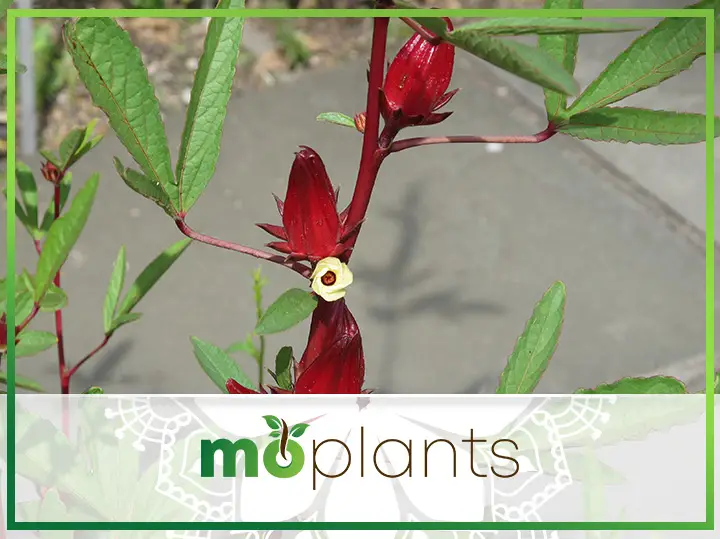- How to Grow the Jamaican Sorrel
- The Weather Requirements
- Knowing When to Plant
- The Lighting Preference
- Using Seeds to Plant Jamaican Sorrel
- Picking the Right Planting Area
- Consider Transplanting, Spacing & Mulching
- Fertilization & Some Extra Care
- Allowing the Process to Takeover
- Harvesting the Right Way
- Understanding the Maintenance
- Infographic
- In Conclusion,
Jamaican Sorrel, Red Sorrel, Roselle, or Florida Cranberry – No matter what you like to call it, is a species of flowering plant from the family of Hibiscus that is native to Africa. However, long before you could find it worldwide, in the 16th to early 17th century, it was mainly present in West Africa before finding its way to Asia and the West Indies.
Today, the gorgeous red plant, mainly known as the Jamaican Sorrel, named after its edible leaves, is a short-lived perennial, growing up to 7 feet tall. It has narrow, lobed leaves and stems that are red and green. A colorful bright addition to your garden, the flowers can be seen blooming in late fall through early winter.
Hence, it is safe to say that the Jamaican Sorrel is one of those rare plants that add some much need greenery and a pop of color during the colder seasons. So naturally, it’s no wonder that the flower bases known as calyces are used to make some delicious jams, jellies, and beverages for the festive times. Hopefully, you are ready to grow your own Jamaican Sorrel.
How to Grow the Jamaican Sorrel
Being a flowering plant, Jamaican Sorrel isn’t a complicated plant to grow and harvest in your own garden. However, like many other flowering counterparts, it has specific requirements, weather and climate demands, and extra care preferences that help with the growing process.
It is also important to understand that the Jamaican Sorrel can grow from both seeds and cuttings. However, if you plan to plant one in your kitchen garden or backyard, seeds would perform much better. In fact, getting started through seeds is easier and almost always is a smooth process of harvesting the Jamaican Sorrel.
In addition to the usual growing and harvesting, some maintenance requirements boost the longevity and health of the plant and its flowers. Moreover, it may also take some fertilizing and pesticides to ward off infestations. So now, let’s get our gloves, seeds, and shovels and get growing!
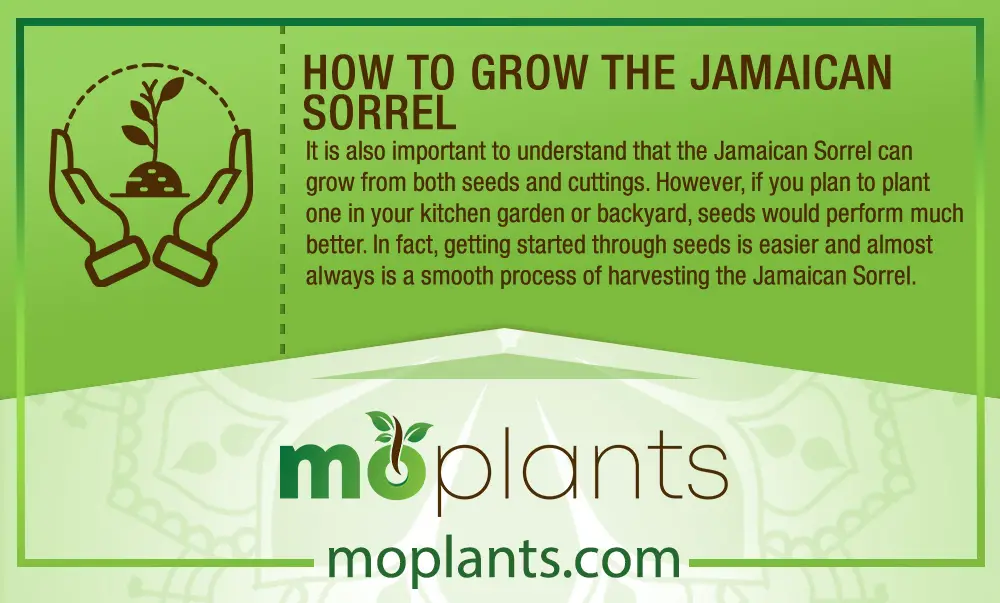
The Weather Requirements
As we mentioned earlier, although the Jamaican Sorrel is now predominantly grown almost all around the world – it is native to West Africa. Therefore, it only makes sense that the plant requires warmer months of the year to have the perfect growing condition for it. That’s why Sudan hosts some of the best, densest flavored Sorrels due to its warm weather conditions.
The Jamaican Sorrel is an easy-going plant that grows without much hands-on processing. It has a distinct requirement for a prolonged summer season. In fact, the warmer the weather is better for the plant. Extended exposure to a hot climate setting plays a vital role in allowing the fruit to ripen.
Hence, if you plan to plant the Jamaican Sorrel and go through a long summer season of up to 4 to 5 months, you are in for a flavorful Sorrel treat. In fact, if all goes as planned, you’ll have a healthy, bushy shrub in your garden with dense red calyces blooming and ripening from receiving the best weather conditions.
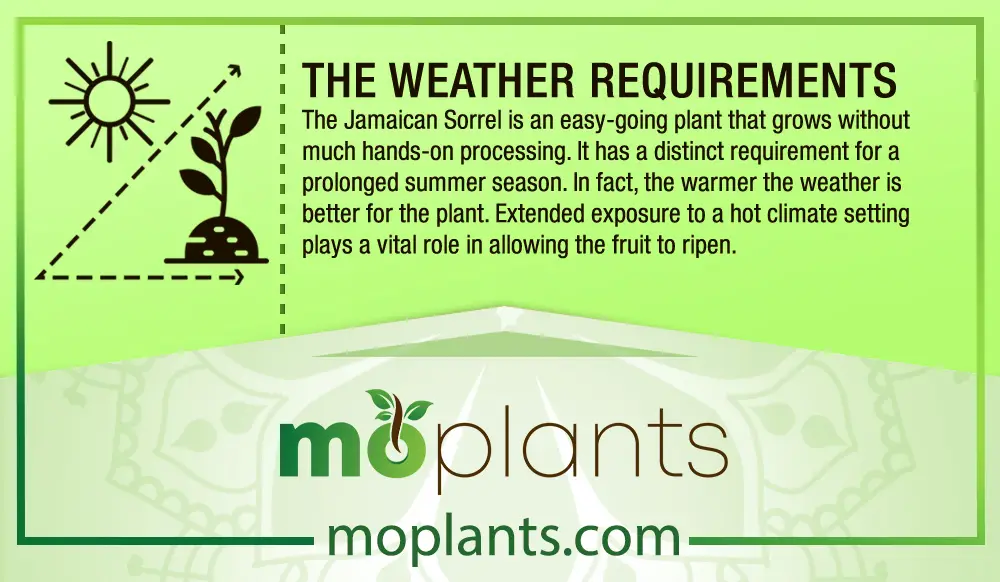
Knowing When to Plant
While the warm weather needs to suffice for the Jamaican Sorrel throughout its growing stages, it is also essential to know when to plant it. In fact, knowing when you need to start seeding for them to receive the perfect weather conditions to grow is of huge essence when it comes to growing a plant.
Therefore, as the Jamaican Sorrel loves the warm weather, you should plant the seeds when the soil temperature has gone over 75°F. The temperature of the soil is of crucial importance as it greatly helps germinate the seeds. Moreover, in its native homeland, the Jamaican Sorrel receives plenty of rainfall too. Hence, it requires constantly moist soil during cultivation.
So considering these weather profile needs of the plant, the summer months starting from March sound just about right to plant your seeds. That is because it allows the plant to start growing in warm weather, continue growing as it gets hotter and humid, and finally find relief in moist soil conditions with rainfall reaching up to 72 inches.

The Lighting Preference
It’s great to plant your Jamaican Sorrel in your garden soil. However, if you are giving it a more personalized start for close attention in the kitchen garden – it still requires the sunniest corner available. Undoubtedly, the Jamaican Sorrel grows splendidly under plenty of light and the consequent warmth it receives by being directly under the sun.
Therefore, considering how much the Jamaican Sorrel can prosper under hot, humid weather and sunlight with lots of rainfall – it is a given that if you live somewhere like Arizona, you naturally have higher stakes at growing a healthy and beautiful Jamaican Sorrel. The arid weather conditions of Arizona make for the best to grow these plants.
Furthermore, assuming you are planting your Jamaican Sorrel in your garden soil, ensure that it is away from any shade from nearby trees or plants. It needs to have its own bright and sunny area to start growing. From there on, it can take somewhere around 5 months to come to the period of buds showing and flowering.

Using Seeds to Plant Jamaican Sorrel
Now that you have understood the basic weather, lighting, and climate requirements that make up the perfect time for planting the Jamaican Sorrel, it is finally time to plant the seeds. However, it is important to note that instead of simply sowing the seeds, a little on-hand preparation can go a long way in the planting and growing process.
Therefore, prepare the seed by slightly tearing the seed coat right before you sow it. Many have noted that preparing the seed before sowing can be vital in its germination process. Even simply loosening the coat of the seed by rubbing them together in your palm is helpful. In fact, if you want to experience excellent germination of your plant, use a seedling tray.
A seedling tray is an effective tool for acquiring high germination. It is an age-old planting technique with promising results. It is great for eradicating most of the initial challenges someone new to planting and gardening may face. It is considered a reliable way of ensuring smooth sowing and planting of Jamaican Sorrel via seeds.

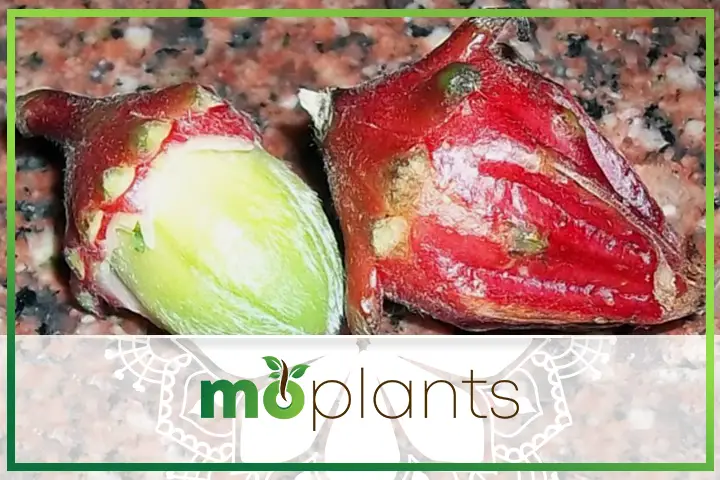
Picking the Right Planting Area
Next comes the step where you have to decide upon the area where you will be sowing your Jamaican Sorrel seeds. However, it isn’t a complicated process to choose as any area where there is enough space for the shrub to grow and spread is perfect. Given the weather conditions cultivating to its process are being fulfilled, an ideal place isn’t difficult to find.
With that being said, one of the few things that you have to take care of consciously is that the Jamaican Sorrel loves the sun. To become a healthy plant, it just has to be under the sunlight for most of its growth spurt. So bear in mind to find a nice, sunny spot with lots of space around the area for the bush to become dense as it grows and expands.
Moreover, when the plant gets heavy with fruits, the stem tends to trail on the ground. The Jamaican Sorrel is known for its long, reddish-green stems. So a clear area can do well for allowing space for the stems to grow the farthest possible. Also, you don’t want it overlapping with other plants nearby as it can obstruct their planting with its weight.

Consider Transplanting, Spacing & Mulching
Sowing seeds using a seedling tray means there will come a time when you will require transplanting them off to an independent soil. But naturally, this step shall too require adequate weather and soil temperature for the transplant to happen smoothly and without compromising the growth spurt your plant has already seen through.
Similarly, spacing is also a much-needed step of the Jamaican Sorrel cultivation period. However, it depends on why you are growing the Jamaican Sorrel in the first place. For instance, if it is nothing more than an aesthetic addition to your garden, 3 feet spacing is ideal. However, if you are going for the calyces, preparing for space mounds almost 6 feet in diameter is best.
Unlike transplanting and spacing, which are conditional, mulching is beneficial unconditionally for all plants. Therefore, you can try mulching with manure to protect against pests, suppress weed growth, and aid soil moisture retention for vital nutrient supply for the plant. So a 2-inch layer of rotted manure spread by avoiding stems is ideal.

Fertilization & Some Extra Care
As mentioned above, the Jamaican Sorrel is easy to grow. However, some extra loving and care go a long way in keeping the plant healthy and growing smoothly. Hence, given that it is a flowering plant, exercise great precaution to keep the seeds pest free. The young plant is at the risk of being raided by pests that will be harder to handle.
Moreover, you may even encounter a possum problem compromising your plant bed. So, good pesticide use is recommended in order to keep the rodents and pests at bay from the plant. Additionally, on the same front of providing extra care, you may have to put in work to keep the weeds from obstructing your otherwise perfect Jamaican Sorrel fruits.
Furthermore, your plant would need some boost via fertilizers with pesticide use. Organic fertilizers can greatly improve your Jamaican Sorrel harvest. A natural, diluted feed spread across the plant bed should do it. Doing this step after every harvest would help ensure the plant is healthy for developing flowers in the next season.
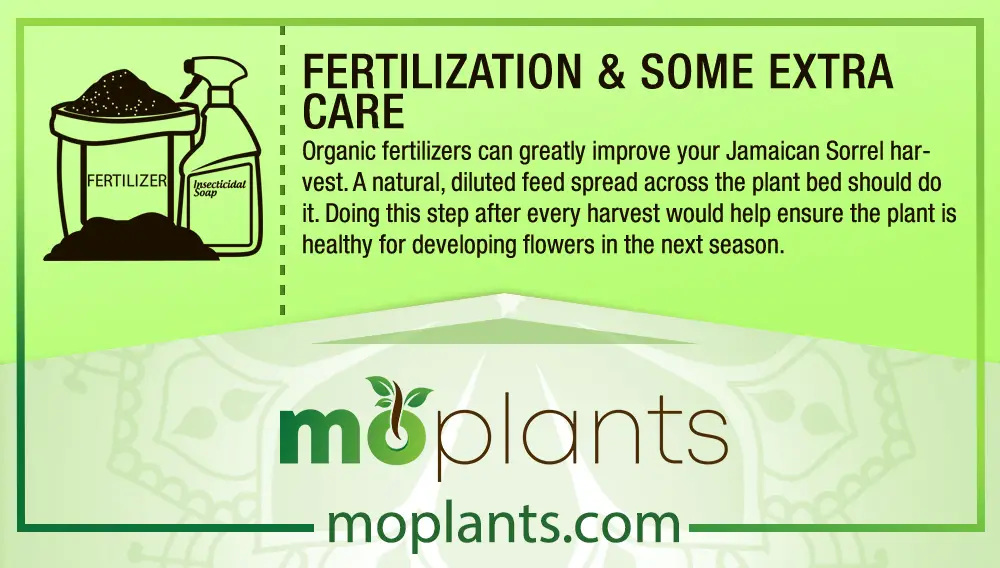
Allowing the Process to Takeover
It is finally time that you have done all that you could do for your seeds to prosper into a glowing, beautiful Jamaican Sorrel plant. You can now sit back, relax, and let the natural process take over. It is also good for you if, instead of worrying and stressing if you have done everything right, let the yield talk for itself.
Sometimes there is less yield. The fruit that the plant bears would be smaller in size, and the issue with being how many fruits are there on one plant. However, on the other hand, sometimes you may achieve the best yield ever. So planning ahead and believing that you will see consistent growth after a yield or two is vital here.
You can mark your calendar as you are waiting on the yield. Expect it to come around in the closing months of the hot weather. This is the best time to find the juiciest fruits for your favorite spreads like jams and jellies and beverages to refresh in the summer season. 3 o 4 shrubs should do for enough fruit for a small family.
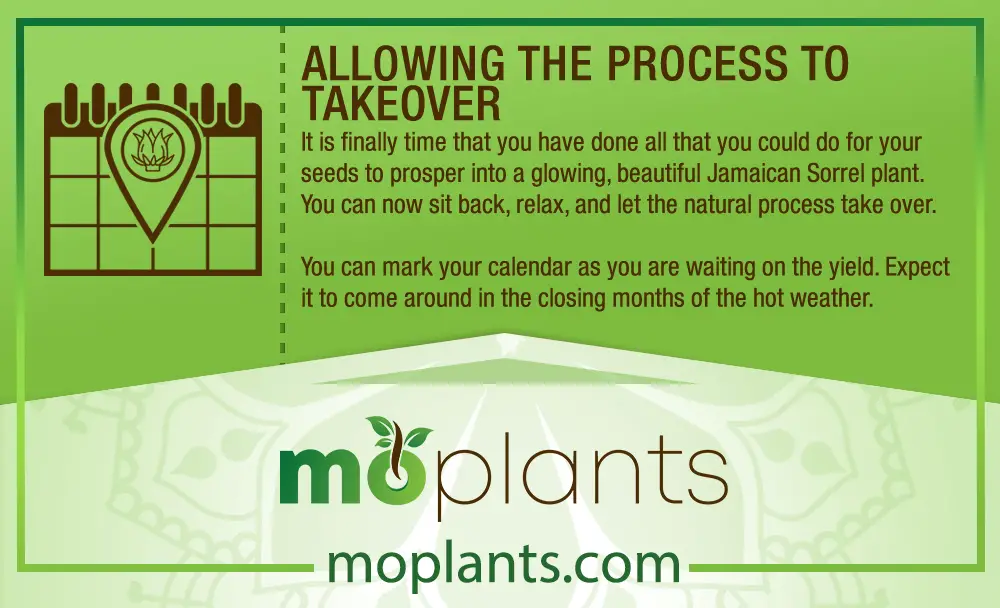
Harvesting the Right Way
The calyces are blooming, love in the air, and you have successfully helped transform a tiny seed into a gorgeous, fruit-producing shrub. So once the flowers can be seen on the bush, they will die out by themselves by noon time or later in the evening as it begins to get dark. From this point, it is a matter of 2 to 3 weeks that you have fruits ready for harvesting.
When the time is up, you need to check your fruit for a day or two to see if it is plump enough and intense in color before you start taking it apart from the plant. However, duly note that waiting for over three weeks means you will be compromising your fruit. If the fruit has not been picked in time, it will dry out and lose its pulp.
Moreover, it is better to use tools like a clear shear to pick the fruit if you aren’t too experienced with flowering plants. Otherwise, simply plucking at the very end of the fruit, avoiding damaging the stem, should suffice with a professional hand. The idea is to leave the stem intact and held together for the next harvest.
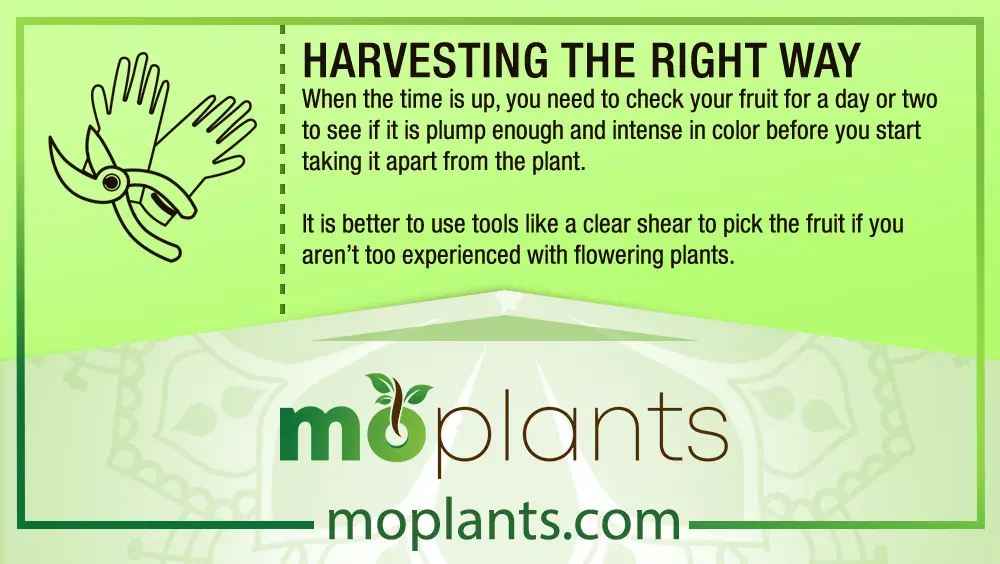
Understanding the Maintenance
Low-maintenance plants such as the Jamaican Sorrel are labeled hardy. Hardy plants do not dry out, nor do they have any specific weak points that need to be taken care of in order to ensure their health. Hence, as the Jamaican Sorrel is also hardy, all you have to do is to ensure that it is watered regularly.
If you are a more hands-on gardener, then you would regularly water your plants in the morning or during the day. However, if you want to make things take care of themselves, an automated watering system via drip irrigation sounds just about right. No need to regulate your plant’s hydration needs anymore.
However, it is crucial to bear in mind that you cannot overwater no matter what. That is the primary reason that can cause your Jamaican Sorrel root to rot. The best way to know that watering is adequate is to touch the soil and see if it is dry. A dry soil bed going up to an inch below the first layer means the plant needs more water.
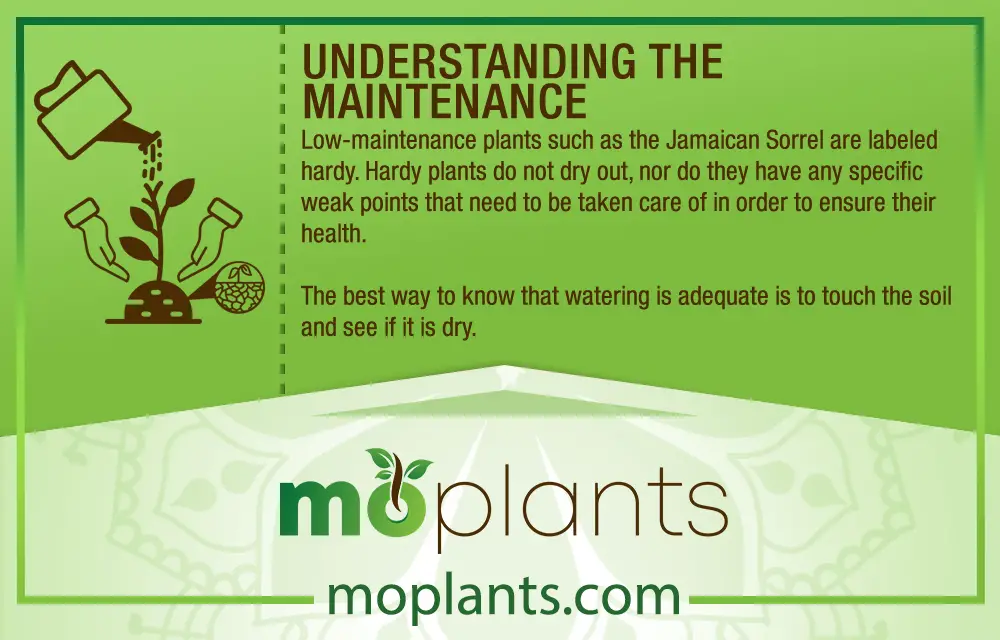
Infographic

In Conclusion,
Jamaican Sorrel is easy to grow, harvest, and maintain the plant. With hardly any challenging demands for the cultivation portfolio, it makes for one of the easiest flowering plants you can grow in warm weather. Like all plants, some extra care and love can go a long way in keeping the shrub healthy and fruit-bearing.
You can use the fruits to make some of the best recipes out there. The fruit can be a great homegrown source for delicious snacks and eateries, from spreads like jam and jellies to beverages like a refreshing ice drink and warm tea. For more planting questions and care guides, connect with us at Mo Plants – your one-stop plant directory for more gardening know-how.

